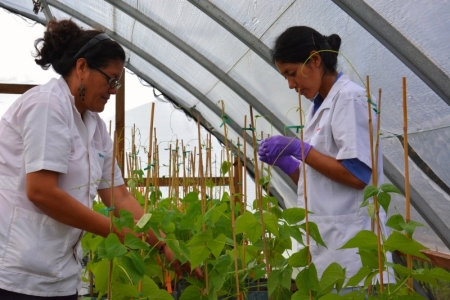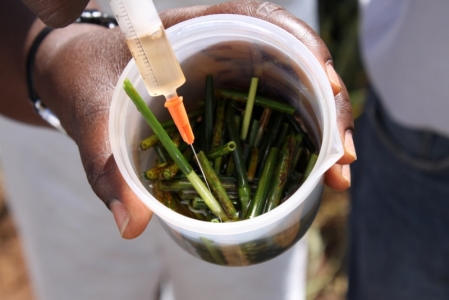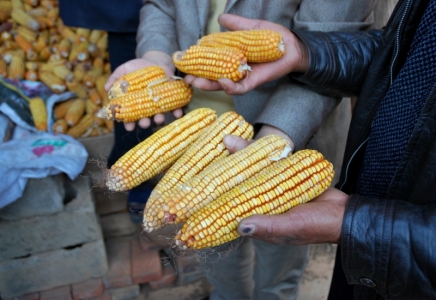Feeding a rapidly growing world population in the era of climate change and resource scarcity will be a great test for human ingenuity. Agricultural biotechnologies, such as genetic engineering could play an increasingly important role.
But to what extent can these technologies help smallholders to develop sustainable food systems, improving nutrition in the context of climate change? This was a key discussion point at a recent meeting of at the Food and Agriculture Organisation of the United Nations (FAO).
“Given the magnitude of the challenge, we must use a broad portfolio of tools to fight malnutrition and to achieve sustainable agriculture” said José Graziano da Silva, Director-General, FAO in his opening speech. Indeed, agricultural biotechnology (or agrobiotechnology) can be seen as a multifarious and rapidly expanding toolbox of technologies, ranging from controversial and fast evolving techniques, such as genome editing and genetic modification (GM), to uncontroversial and widely used conventional non GM plant and animal breeding methods.
Research and Development experts reports impressive positive impacts of the use of both conventional agrobiotechnology and GM technologies on agricultural productivity and sustainability. Examples of the sorts of technologies include livestock vaccines, disease diagnostics and the use of DNA marker assisted breeding to speed up the selection process when developing new crop varieties. All of these technologies have already improved crop and livestock productivity for millions of small-scale farmers around the world. There is, however, a common agreement that agrobiotechnology is not a means in itself, but has to be combined with other disciplines and drivers such as agroecology, functional markets and value chains, to be fully effective.
Even though FAO in general and many of the event’s participants are positive about the use of agrobiotechnology, the use of GM technologies continues to cause debate in the international community. Controversies about GMvary from stakeholder to stakeholder and revolve around a combination of concerns about safety for human and environmental health, market control and proprietary issues linked to the use of technology, and to what extent GM technologies are relevant for and accessible to small scale farmers in the Global South.
 Climate change and variability demands new varieties of beans. Photo by J.L.Urrea, CCAFS via Flickr CC BY-NC-SA 2.0.
Climate change and variability demands new varieties of beans. Photo by J.L.Urrea, CCAFS via Flickr CC BY-NC-SA 2.0.
The future is already here, but it’s not evenly distributed
So what about GM crops? “Cutting and pasting” genes from one cell to another has made it possible to modify and improve crops, trees and animals in an increasingly effective manner. GM crops are today cultivated by some 18 million famers, a large proportion of who are cotton farmers in India, Pakistan and China. GM crops cover 180 million hectares, which is 70 times the crop cultivation area of Sweden.
The benefits of the first generation of GM crops include more climate smart soil management, a reduction in the use of insecticides and increased farm profitability. The current GM trait and seed market is however heavily concentrated among a few multinational actors and three major global feed and commodity crops, maize, soybeans and cotton.
The second generation of GM crops is still in the R&D pipeline. Developed by a broader set of actors, second generation GM crops include varieties with increased drought tolerance, nutrient uptake and better storage properties. What’s more, some of the GM crops of the second generation have improved nutritional characteristics, such as biofortfied cassava, banana and rice with improved protein, vitamin and micronutrient content. These crops are of interest to small scale farmers and also for the food insecure.
Despite the obvious benefits, it will take many years for the second generation of GM crops to reach small scale farmers because of the regulatory hurdles, demanding biosafety assessments, inefficient dissemination pathways and weak seed markets. So, while genetic engineering is becoming progressively more influential in shaping agricultural production systems in countries like United States, Brazil and Argentina, the technology outreach to small scale farmers in low-income countries is still very limited.
There is still a wide gap between what can be achieved with advanced biosciences and what has been done so far. Not surprisingly, many developing country representatives at the FAO meeting expressed the need to step up capacity building efforts to strengthen innovation, technology assessment and dissemination systems within their own countries, adopting modern biosciences appropriate to the needs of their own farming communities.
 Demonstrating stem rust inoculation of wheat plants by injection. Photo by Petr Kosina, CIMMYT via Flickr CC BY-NC-SA 2.0.
Demonstrating stem rust inoculation of wheat plants by injection. Photo by Petr Kosina, CIMMYT via Flickr CC BY-NC-SA 2.0.
Precision breeding technologies – A game changer
To me, the most exciting discussion at the symposium was about the rapid development of new molecular precision breeding technologies, such as genome editing using the CRISPR-Cas system. (Note: CRISPR stands for clustered regularly interspaced short palindromic repeats.)
Compared to its predecessors in the world of genetic modification, these systems are highly specific and allow scientists to zero in on a single gene and turn it on or off, or remove it. In his talk at the FAO, Professor Denis Murphy from the University of South Wales (UK), suggested that the combination of new genome editing technologies with bioinformatics will allow us to “Move from the era of steam engines to the jet age in terms of breeding new plant crops, animals and trees.” Although there are intellectual property (IP) issues and barriers building up around these technologies, the hope is that their low cost and user friendliness will enable low-income countries to leapfrog into the world of precision breeding.
Denis Murphy also suggested that it may be possible to develop so-called ‘open source’ versions of the new gene editing technologies that could be used for public good purposes in developing countries. This would be good news for farmers in these countries who will be able to benefit from breeders in their own countries, improving the crops of most interest to them. The hope is also that these new molecular precision breeding technologies could provide new tools for participatory plant breeding efforts, where researchers could work together with farmers to develop improved crops, and livestock for various agro-ecological needs. This would, for example, allow researchers to assist Andean potato farming communities in climate change adaptation by efficiently incorporating disease and stress resistance into a multitude of locally grown potato varieties, protecting highly valuable agrobiodiversity.
Gene editing is an important step forward in the development of modern biosciences, but the question is how this ever expanding plant breeding toolbox should be regulated? Precision breeding often involves genetic modifications during the research stage, where the final crop doesn’t contain any foreign genes and where its genetic makeup can be identical to those found in the wild.
My fear is that if precision breeding were regulated in the same way as GM technologies are regulated today, it would stifle the development of a broader innovation agenda with clear benefits to smallholder farmers facing challenges of productivity under the climate change. If this happens, it is only the large private sector actors, with their often narrow breeding focus, who would have sufficient resources to pull the next generation of precision breeding crops through the regulatory systems. Another concern is to what extent patents and IP barriers will restrict access to these technologies, as has been the case with GM technologies.
 Comparing improved hybrid maize with local variety in Yunnan Province, China. Photo by Michelle DeFreese, CIMMYT via Flickr CC BY-NC-SA 2.0.
Comparing improved hybrid maize with local variety in Yunnan Province, China. Photo by Michelle DeFreese, CIMMYT via Flickr CC BY-NC-SA 2.0.
Finding the balance. The role for FAO
There is a strong belief, advocated by the NGO sector, that agrobiotechnology, and in particular genetic engineering, provides multinational corporations with the means to dominate the global food system, disadvantaging smallholder farmers and consumers. Even though I do not share this view, it’s true that, unlike the Green Revolution which was realized through technology transfer from the public R&D sector, the ‘Gene Revolution’ is mainly driven by the private sector.
Many experts at the FAO meeting felt that this need not be the case in the future. By expanding the innovation agenda and supporting the capacity of the public sector, the promise of the genome revolution can be delivered to a broader set of users, including smallholder farmers and consumers in low income markets.
What is more, public institutions are not necessarily the best agents for technology dissemination and commercialization. This tends to be done better by the private sector and market actors. In my view, Public-Private Partnerships (PPP) have an increasingly important role to play in the dissemination and transfer of appropriate agro-biotechnology applications. There are many encouraging signs of public, private and civil society organizations partnering for knowledge and technology transfer – FAO should be a platform for discussing such partnerships, highlighting success stories and identifying best practices.
The issue of Intellectual Property rights to new breeding technologies, such as genome editing, generates heated debate. The question is to what extent patents, mostly held by the private sector and public institutions in affluent countries will restrict the use of new technologies for breeding in the low-income countries. Professor Louise Fresco from Wageningen University argued that “a balance needs to be struck between the desire for open access, providing small-scale farmers in developing countries with access to new precision technologies, and private sector’s desire to use patents to restrict access and secure investments in a technology which is very costly to develop”. This continues to be a thorny issue, but there are examples of PPPs and innovation partnerships that can be used as models for establishing such balance.
FAO can provide a neutral platform for discussing best practices, for catalyzing capacity building and for identifying how agrobiotechnology can benefit smallholders in developing sustainable food systems and improving nutrition under the changing climate. Professor Fresco summarized her expectations, which I share, in the following way “FAO places itself at the heart of a new debate that goes beyond the black and white, for or against GMOs; a debate that goes beyond agricultural production and small scale famers, and includes the entire food value chain; a debate that is beyond merely science, involving government, civil society and private sector.” Let’s hope FAO will be able to deliver on these high expectations.